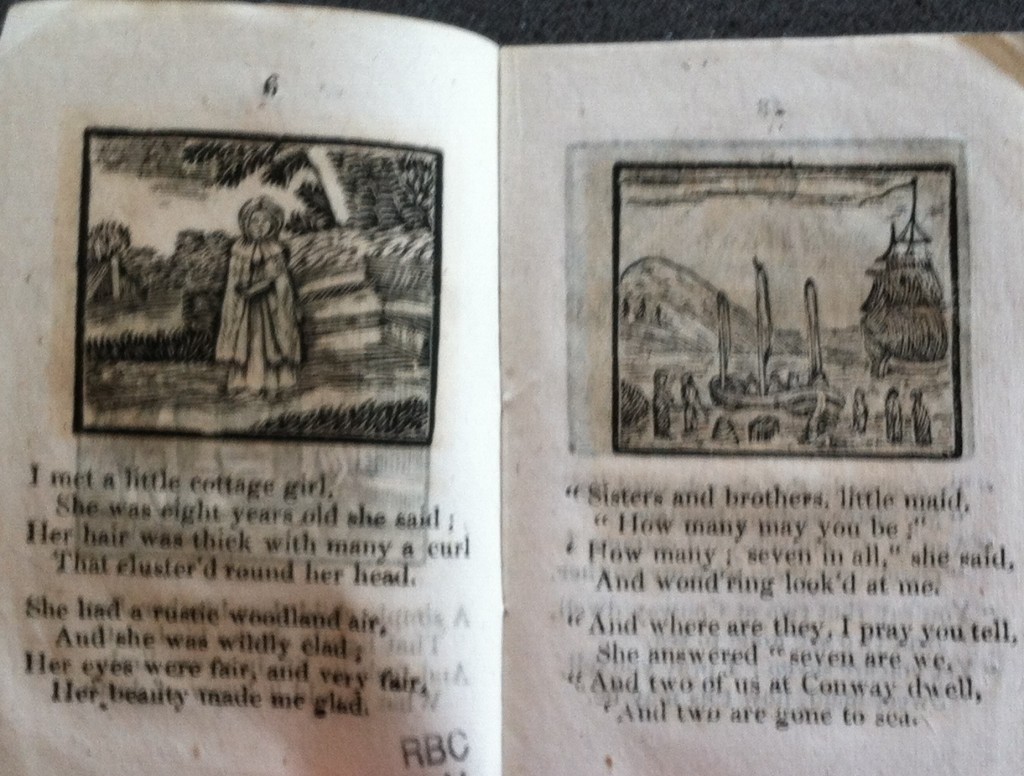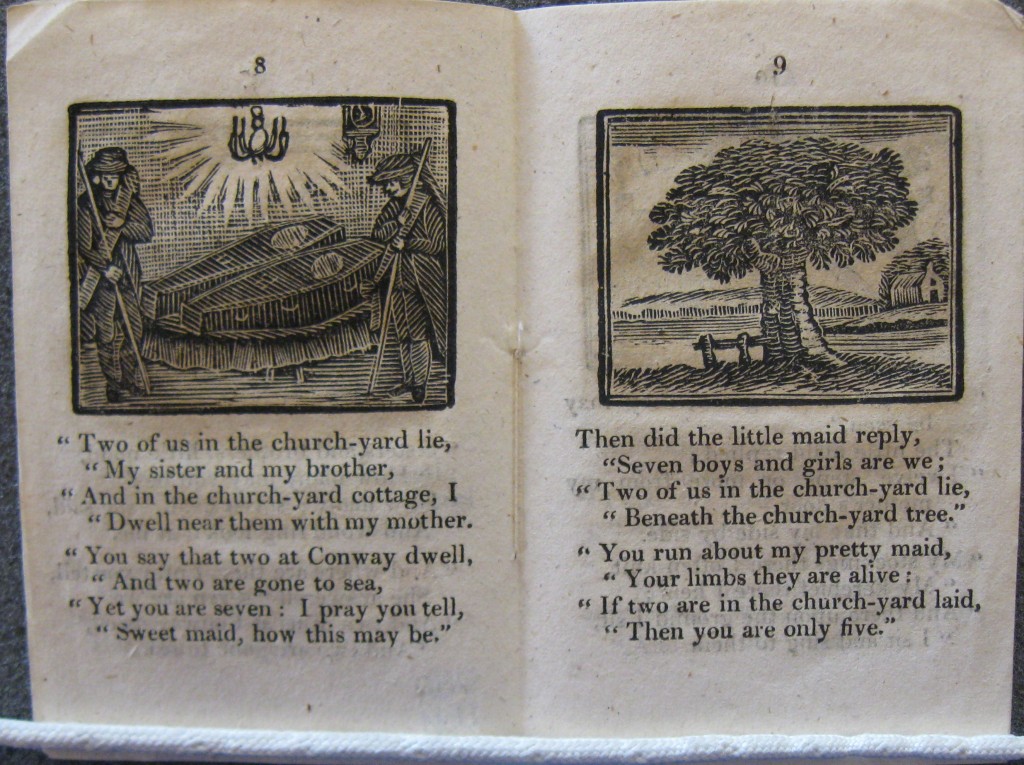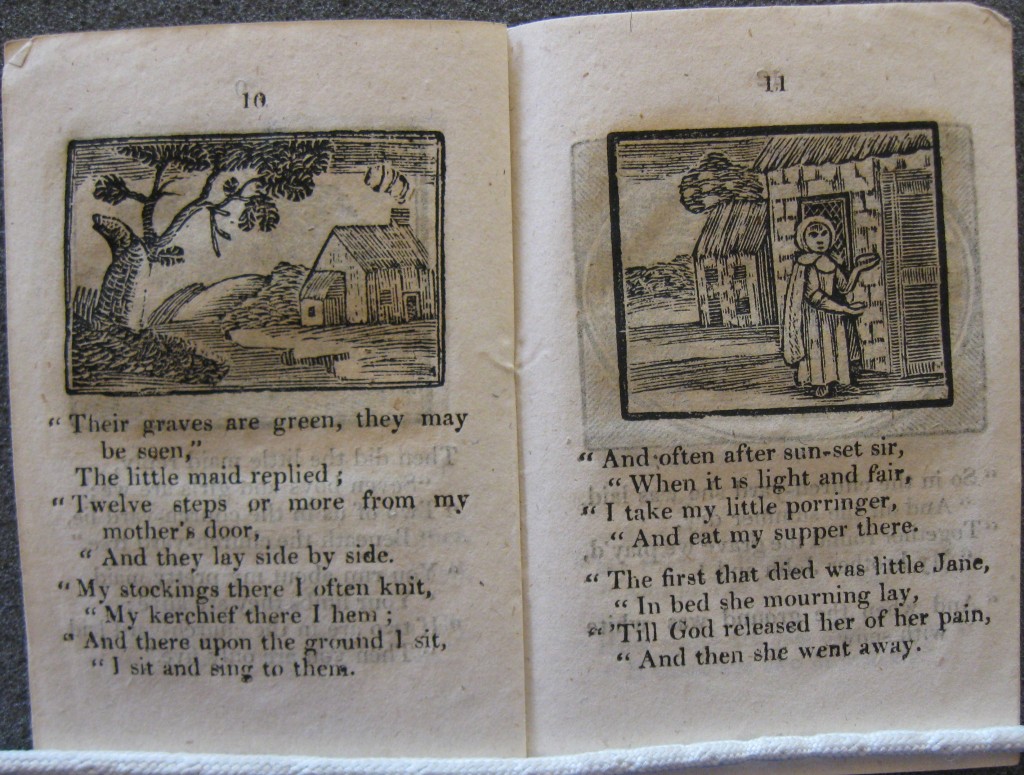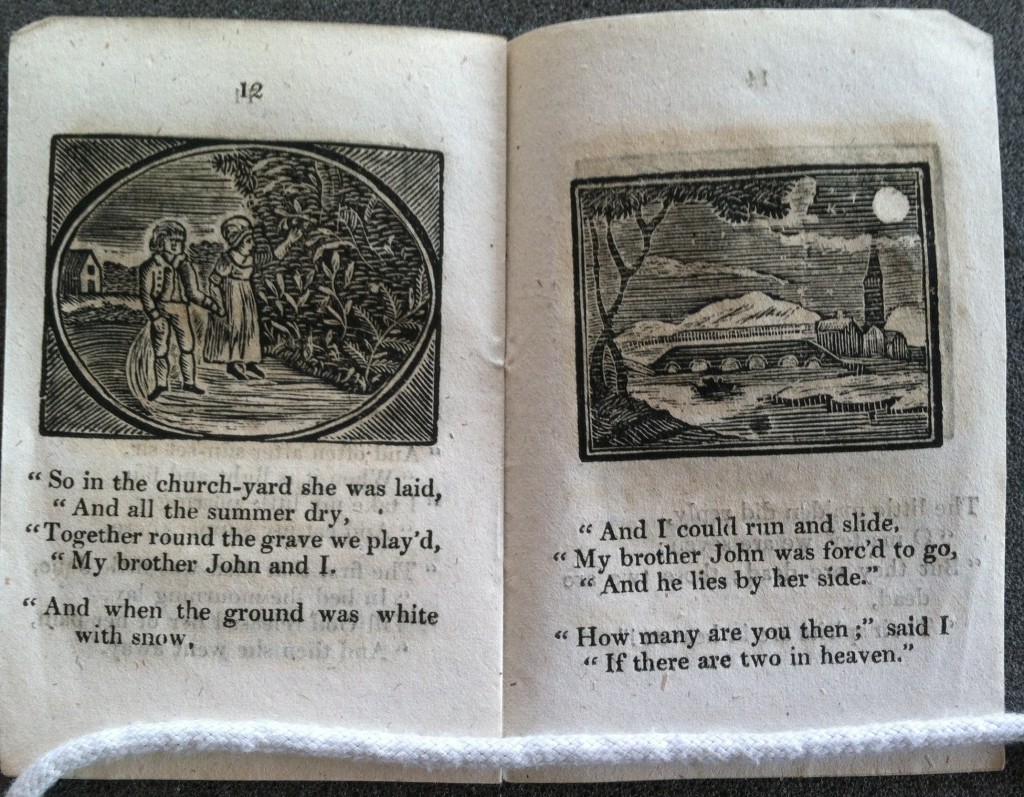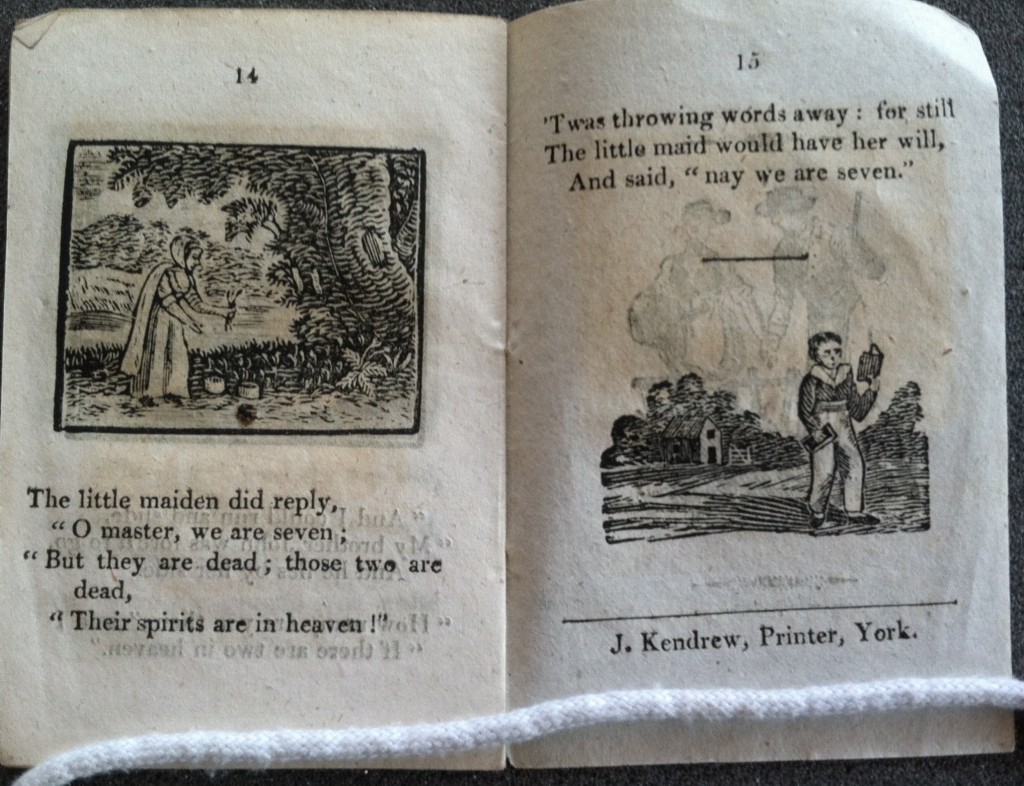“The Little Maid and the Gentleman; or, We Are Seven”: Some Thoughts on an 1830ish Chapbook
In the 1820s and 1830s, James Kendrew published a series of chapbooks for children. Most of these are stories about Simple Simon, or Jack Spratt, or Tom Thumb, but one is “The Little Maid and the Gentleman; or, We Are Seven.” 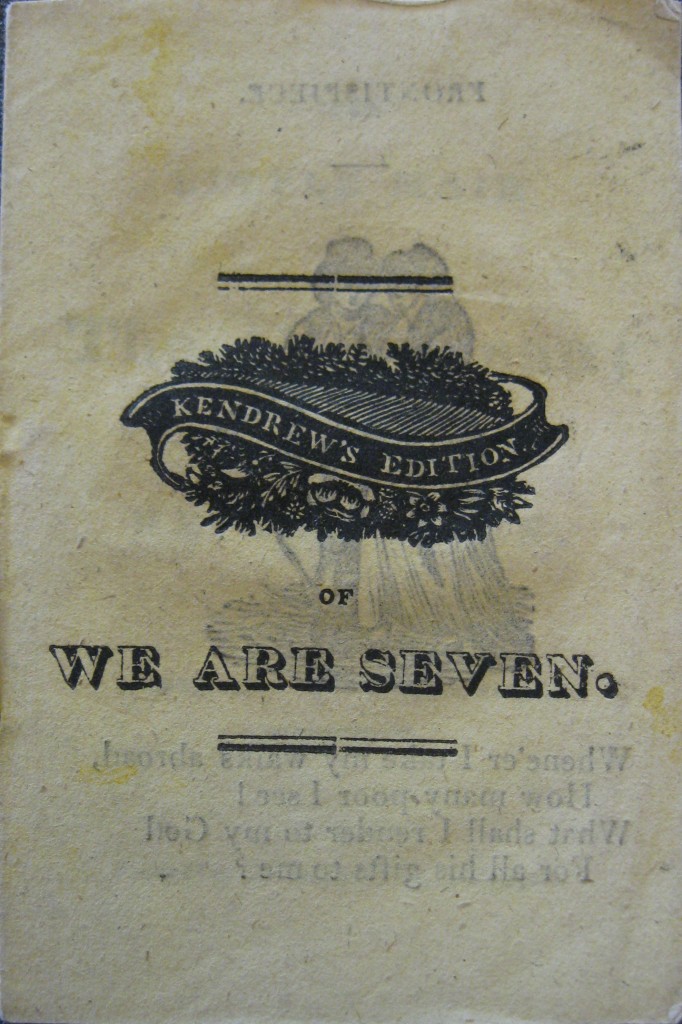 Kendrew reprints Wordsworth’s poem, adding the new title and including woodcuts for each stanza.
Kendrew reprints Wordsworth’s poem, adding the new title and including woodcuts for each stanza.
The poem, if you’re not familiar with it, stages a conversation between the speaker and a young girl, about how many siblings she has: she insists she has six (and hence the titular “we are seven”), but since two of them are dead, the speaker insists she has only four. When teaching about childhood, poetic form, or Romanticism, I find it a great introduction for students: it’s short and accessible, it touches on issues of voice, gender, adult/child power dynamics, death, and presence/absence, and its publication in Lyrical Ballads makes it a great starting point for discussions of Romanticism.
I came across Kendrew’s version just last week. I’m spending three weeks at the National Humanities Center in Research Triangle Park, and the archivists at the Rare Book Collection at UNC Chapel Hill were kind enough to show us some of their holdings. Emily Kader, the rare book research librarian, showed us this book (library listing here). I found it fascinating, and it spurred me to ask some questions about the textual history of the poem — which I answer below, if you’re interested. If not, just skip the text and look at the pictures.
The Text
What first interested me about this book was the first line, which differs from the version reprinted in the Norton Anthology (from which I usually teach). I always make a big deal out of the first stanza, which is formally and thematically distinct:
———A simple Child,
That lightly draws its breath,
And feels its life in every limb,
What should it know of death?
The first line has only two feet, I always point out, breaking the ballad meter the rest of the poem will continue (except for the 5-line final stanza). And the stanza poses a question whose meaning will be reevaluated over the course of the poem. Is it rhetorical (as in, of course a child should know nothing of death)? Or is the poem genuinely exploring what a child should know of death?
Here’s how the poem begins in the 1820 broadside edition I saw in the archive:
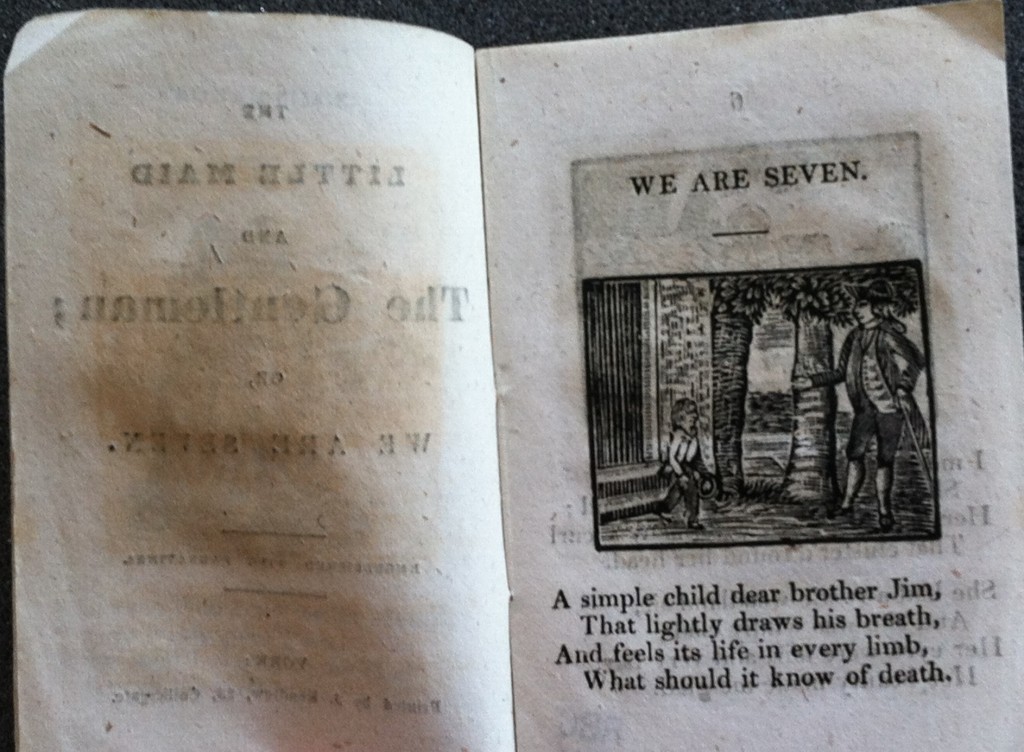
That first line has all its feet! (I thought). Where did that awful “dear brother Jim” come from? (I asked myself). Did Kendrew add the line to fill out the meter? Given the title page, I might have been right:
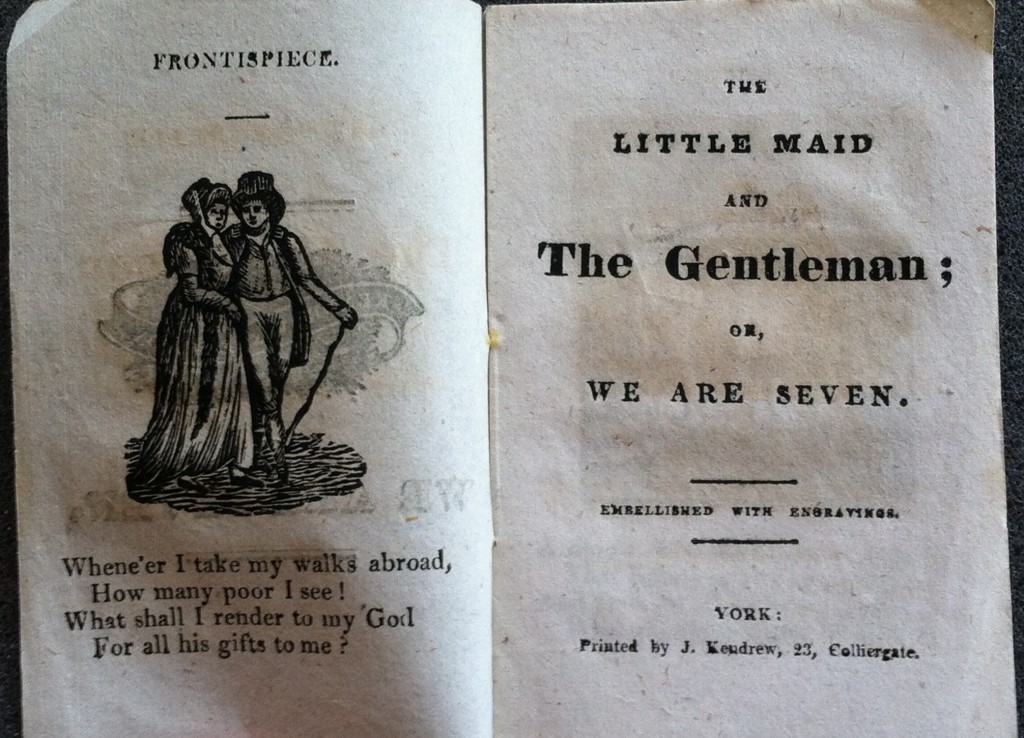 Not only does this edition add a new title, making the original title secondary, but Wordsworth isn’t mentioned at all, and the frontispiece includes the first stanza of an Isaac Watts hymn.
Not only does this edition add a new title, making the original title secondary, but Wordsworth isn’t mentioned at all, and the frontispiece includes the first stanza of an Isaac Watts hymn.
But it turns out, I just didn’t know (or had forgotten) the textual history of the poem. I knew Coleridge had contributed the first stanza, after Wordsworth recited the poem, and so I looked up Wordsworth’s comments. Sure enough, Coleridge gave him the first line, “A little child, dear brother Jem.” Wordsworth found the “dear brother Jem” part ludicrous, but liked the sly reference to their friend James Tobin, who went familiarly by Jem, and so kept it in (changing Jem to Jim). The line remained in all four editions of Lyrical Ballads (1798, 1800, 1802, and 1805), as you can see on the Romantic Circles edition.
Most versions of the poem drop those three words (a change that, frankly, improves the poem a lot). So when did Wordsworth change the first line? According to the definitive Cornell edition of Wordsworth’s poems, the first line was changed for the 1815 Poems by William Wordsworth.
So here’s where things got interesting. For some reason, Wikipedia (always eclectic in its knowledge) knows about the Kendrew edition of “We Are Seven,” claiming “In 1820, the poem was republished as a broadside and titled ‘The Little Maid and the Gentleman'”. The citation is F. W. Bateson’s Wordsworth: A Re-Interpretation (1954). Bateson makes essentially a passing reference:
William at any rate was never entirely at ease in the company of his social inferiors. It was not snobbery, but a consciousness of the immensity of the gap that separated the rich and the poor. A broadside version of “We Are Seven” that was published about 1820 has the alternative title, “The Little Maid and the Gentleman.” One point certainly of the poem is that the two interlocutors live in different social worlds… (p. 49)
Bateson uses the alternative title to make a claim about Wordsworth’s unease with his social inferiors. More recently, Heather Glen mentions this title as evidence that Wordsworth is interested in class differences (Glen 26). Anne Carson is pictured holding an edition of this book in the NYPL’s Know the Past, Find the Future, promoting the library’s centennial: it’s described as “a booklet with a poem by William Wordsworth.” And the book is listed in the 1914 Cambridge History of English Literature, along with Wordsworth’s other books (p. 407).
These writers seem to assume Wordsworth was involved. But Wordsworth had changed the first line by 1820, the earliest posited date (Mark L. Reed, based on damage to woodcuts also used in Kendrew’s other books, argues for a later date, closer to 1840). In a footnote to John Clare’s “Popularity in Authorship,” John Birtwhistle claims that “We Are Seven” had entered the popular culture as an anonymous ballad, and he cites Kendrew’s edition as a possible referent for Clare’s comment that he’d seen Wordsworth “hawked around in penny ballads.” Tina Hanlon, another scholar with me at the NHC, manages a collection of oral tales from Appalachia, in which she recalls seeing this poem presented as an oral poem (with no reference to Wordsworth), providing further evidence for Birtwhistle’s claim.
This little book, then, has quite a history: it’s used both as evidence both for Wordsworth’s class distinctions, and for the poem’s disconnection from the poet. We could reconcile the seemingly incompatible arguments, I suppose, if we see the title as an interpretation: perhaps Bateson and Glen don’t really mean to imply Wordsworth is responsible for the title, simply that the title is a fitting one, based on the content of the poem. That seems much more plausible, at least to me. Perhaps a scholar better versed in piracies and unauthorized versions of Romantic poems would know more.
The Illustrations
The Toronto library listing explains, “Some of the illustrations are Bewick woodcuts which appeared in A New Year’s gift and were also used to illustrate The entertaining story of Little Red Riding Hood.” UNC Greensboro specifies which pages contain Bewick woodcuts: 6, 11, and 14 (knowing they’re from Little Red Riding Hood, you could probably guess that). As Reed indicates, these are more likely imitations of Bewick, which makes sense (it’s unlikely Kendrew would have obtained Bewick’s original wood blocks).
Bewick, of course, is of interest to scholars of nineteenth-century childhood: Jane Eyre, in the first chapter, is flipping through The History of British Birds and “With Bewick on my knee, I was then happy: happy at least in my way. I feared nothing but interruption,” which soon comes in the form of John Reed.
The Greensboro listing claims that this was the 7th in a 26-book series of toy books. It might be of interest to scholars of Wordsworth, picture books, or children’s literature, and isn’t viewable (with Kendew’s other chapbooks) at archive.org. So, with the kind permission of the UNC Chapel Hill Rare Book Collection, you can read “The Little Maid and the Gentleman” here:
Note: Kurt Fosso uses page 8 on the cover his monograph Buried Communities: Wordsworth and the Bonds of Mourning (2004).
Works Cited (besides those linked in the text)
Bateson, F. W. Wordsworth: A Re-Interpretation. London: Longmans, 1954.
Glen, Heather. “‘We Are Seven’ in the 1790s.” Grasmere, 2012: Selected Papers from the Wordsworth Summer Conference. Richard Gravil, ed. Wordsworth Conference Foundation, 2012. pp. 8-33.
Lyrical Ballads and Other Poems, 1797-1800. James Butler and Karen Green, eds. Cornell University Press: Ithaca, 1992.
Reed, Mark L. A Bibliography of William Wordsworth, 1797-1930. Cambridge: Cambridge University Press, 2013. The book under consideration is numbered A44.
Wordsworth’s comments about the poem were told to Isabella Fenwick in 1843, and are often reprinted with the poem (Wordsworth also talks about Coleridge and the composition of The Rime of the Ancient Mariner).
In addition to the copy I saw at UNC Chapel Hill (one of two), copies of this book can be found at UNC Greensboro; University of Toronto; Toronto Public Library; Wayne State University; and for sale at David Mills Books. There also seems to be a 1970 reprint, at Johns Hopkins
